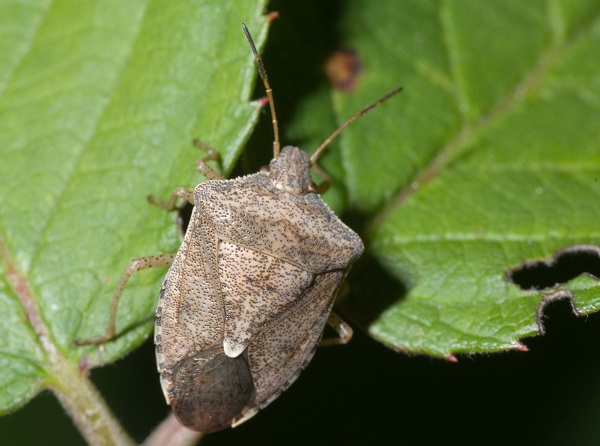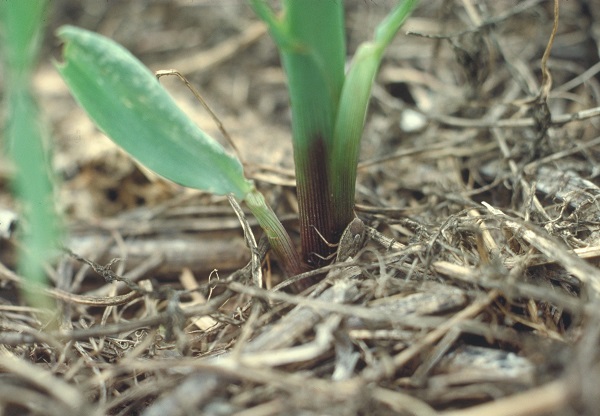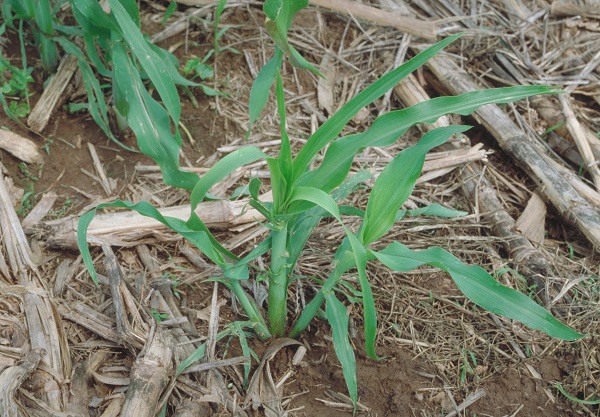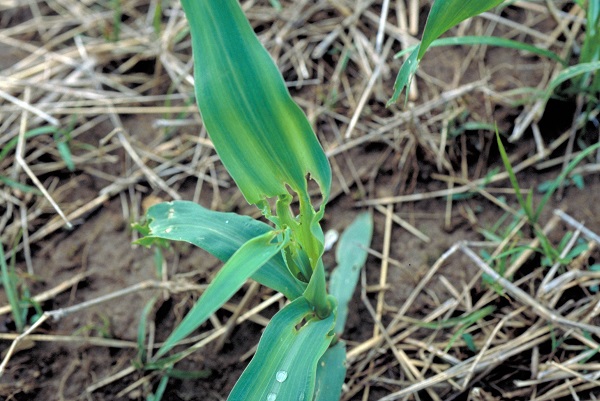Stink Bug Damage to Corn
ENTFACT-305: Stink Bug Damage to Corn | Download PDF
by Ric Bessin, Extension Specialist
University of Kentucky College of Agriculture
Stink bug damage in corn was first recognized as a problem in 1985. Most often only a very small percentage of fields are affected by these insects, however damage has been seen across a wide area of Kentucky.
Brown and one-spotted stink bugs are the most common stink bugs found attacking corn. These insects are 1/2-inch long, shield shaped insects with piercing-sucking mouthparts. The upper side of the body ranges from light to very dark brown. The underside varies from light yellow to green.

Figure 1. Brown stink bug commonly attacks seedling corn.
Stink bugs feed on a wide variety of cultivated crops and weeds. Soybeans are a favorite late summer host, and dramatic growth in soybean acreage during the recent years has contributed to steadily increasing numbers of these insects. This increase coupled with certain cultural practices and crop rotation, can lead to stink bug damage to early growth stages of corn.
Damage and Symptoms
Stink bugs feed on plant fluids by inserting their needlelike mouthparts into stems, leaves or seed pods. While feeding, they inject materials into the plant to aid in digestion and sap removal.
Penetration by the mouthparts can cause physical damage, much like stabbing the plant with a fine needle. A combination of mechanical and chemical damage to the growing point of the plant may be responsible for the injury and symptoms seen in the field.

Figure 2. Stink bug can feed at the base of developing corn seedlings.
Stink bug feeding causes three types of damage. They may kill small seedlings, produce stunted plants, or cause "suckering" (the production of tillers from the base of damaged plants). Frequently a series of plants along a row may exhibit a progression of these symptoms, giving a stair step appearance (dead seedlings, stunted plants, and tillering).

Figure 3. Four irregular holes across a leaf are characteristic of stink bug damage.
There is usually a row of oval holes with yellow borders across the unwrapped leaves of damaged plants. This row results from the single feeding puncture that penetrates the wrapped leaves. A slimy, decaying area may be found in the stalk where the stink bug has fed. This probably results from activity of the insects digestive juices.

Figure 4. Stink bug damage to the growing point can cause tillering of the plant.
The most dramatic symptom is tillering of damaged plants. Tillering usually first appears about 10 days after the damage was caused. A shoot begins to grow from the base of the plant and may become as large as the original plant.
Damaged plants may develop misshapen ears in place of the tassel. Some herbicides can cause similar injury to developing corn. However, stink bugs will leave "styletes" in the plant tissue at the site of feeding. Laboratory staining of the leaves to detect the styletes can provide positive diagnosis of stink bug feeding.
Tillage System Influence
Stink bug damage is most severe in no-tillage fields. In this case, the damage can be found throughout the field, often with areas of more intense damage. Frequently these are near wooded areas. Stink bug damage can be found in conventional fields, but the incidence of damaged plants is low and usually frequently limited to the border rows.
Surveys in Kentucky and adjacent states have identified a soybean-wheat-corn sequence as especially favorable for stink bug damage. A stink bug population can build up in soybeans during podfill. Wheat cover crops provide an attractive early spring host for the insects, and subsequently they feed on emerging corn. The stink bugs may overwinter in the wheat stubble, or they may leave the field for over wintering sites and return in the spring.
Yield Loss
Stink bugs can reduce yields in several ways. First, their feeding may kill small seedlings, resulting in stand reduction. Second, surviving plants are stunted and generally have reduced root mass. These plants may then be more susceptible to other stress-producing factors such as dry weather or attack by other insects. Stunted plants may catch up in height with undamaged plants in 2 to 4 weeks, but research atthe University of Kentucky indicates that yield from these plants will be reduced about 10%.
Tillered plants may produce little if any grain. Some may produce small ears, with about 1/3 the yield of undamaged plants. In some cases the ears forms where the tassel normally appears. Tasseling and silking of these plants may be delayed a week or more. Tillered plants may grow to a height of several feet. In effect, they have been converted to weeds, competing for water and nutrients with undamaged plants.
Management
Scouting is the most effective way to deal with stink bug damage. The potential for crop injury is lower than that for cutworm infestations, so the preventive programs are not economical or recommended. The two weeks following corn emergence are the critical times to be watching for damage. Scout the field as you would for cutworms. In addition to looking for cut plants, the symptom of cutworm activity, look for stink bugs and their damage. Stink bugs tend to feed at the base of corn plants, usually an inch above the soil surface (see below). Special attention should be given to fields where stink bug injury has been seen in past years. The insecticides recommended for cutworm "rescue" treatments in ENT-16, "Insecticide recommendations for conventional and no-till field corn", can be used if a problem is found.
Revised: 11/19
CAUTION! Pesticide recommendations in this publication are registered for use in Kentucky, USA ONLY! The use of some products may not be legal in your state or country. Please check with your local county agent or regulatory official before using any pesticide mentioned in this publication.
Of course, ALWAYS READ AND FOLLOW LABEL DIRECTIONS FOR SAFE USE OF ANY PESTICIDE!
